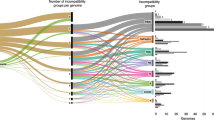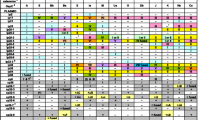Abstract
With the eventual goal of characterizingLegionella pneumophila serogroup 1 plasmids at the molecular level, we have analyzed the plasmid contents of 78 clinical and environmental Spanish isolates. After selection of a suitable alkaline lysis method, we detected plasmids with approximate molecular weights of 25, 36, 40, 61, 80, 85, 90, and 95 megadalton (MDal). Several factors (i.e., wide temporal and geographic distribution, high frequency in both clinical and environmental isolates, and apparent high copy number after subculturing) make the 36 MDal type IA plasmid an appropriate plasmid for further molecular studies.
Similar content being viewed by others
Literature Cited
Aye T, Wachsmuth K, Feeley JC, Gibson RJ, Johnson SR (1981) Plasmid profiles ofLegionella species. Curr Microbiol 6:389–394
Birnboim HC, Doly J (1979) A rapid alkaline extraction procedure for screening recombinant plasmid DNA. Nucleic Acids Res 7:1513–1523
Edelstein PH (1981) Improved semiselective medium for isolation ofLegionella pneumophila from contaminated clinical and environmental specimens. J Clin Microbiol 14:298–303
Edelstein PH, Nakahama C, Tobin JO, Calarco K, Beer KB, Joly JR, Selander RK (1986) Paleoepidemiologic investigation of Legionnaires' disease at Wadsworth Veterans Administration Hospital by using three typing methods for comparison of legionellae from clinical and environmental sources. J Clin Microbiol 23:1121–1126
Kado CI, Liu S-T (1981) Rapid procedure for detection and isolation of large and small plasmids. J Bacteriol 145:1365–1373
Mayer LW (1988) Use of plasmid profiles in epidemiologic surveillance of disease outbreaks and in tracing the transmission of antibiotic resistance. Clin Microbiol Rev 1:228–243
Pfaller M, Hollis R, Johnson W, Massanari RM, Helms C, Wenzel R, Hall N, Moyer N, Joly J (1989) The application of molecular and immunologic techniques to study the epidemiology ofLegionella pneumophila serogroup 1. Diagn Microbiol Infect Dis 12:295–302
Ristoph JD, Hedlund KW, Allen RG (1980) Liquid medium for growth ofLegionella pneumophila. J Clin Microbiol 11:19–21
Shapiro JA (1977) Bacterial plasmids. In: Bukhari AI, Shapiro JA, Adhya SL (eds) DNA insertion elements, plasmids and episomes. Cold Spring Harbor, NY: Cold Spring Harbor Laboratories, pp 601–704
Thomas NR, Koshy S, Simsek M, Abraham AK (1988) A precaution when preparing very large plasmids by alkaline lysis procedure. Biotech Appl Biochem 10:402–407
Winn WC Jr (1988) Legionnaires disease: historical perspective. Clin Microbiol Rev 1:60–81
Author information
Authors and Affiliations
Rights and permissions
About this article
Cite this article
de Felipe, F.L., Martínez-Suárez, J.V. Wide distribution of a 36-megadalton plasmid among clinical and environmental Spanish isolates ofLegionella pneumophila serogroup 1. Current Microbiology 23, 233–236 (1991). https://doi.org/10.1007/BF02092284
Issue Date:
DOI: https://doi.org/10.1007/BF02092284




